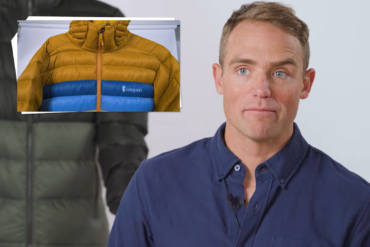[leadin]I held a loaded backpack over my head and inched along an unseen ledge, nipple-deep in freezing water. My skin scraped against stone, the edge of a slot canyon threatening to push me down.[/leadin]
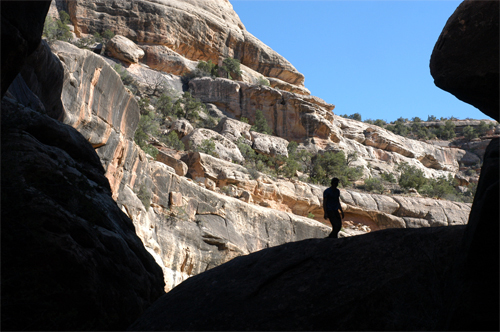
A slip would mean swimming, a wet pack, and, under the gaze of my fellow canyoneers, some wounded pride.
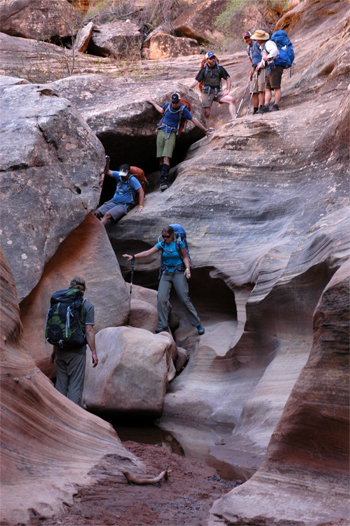 We were three days into a trip in the Cedar Mesa region of Utah. My legs ached but, amazingly, my hair was still dry. A bit more struggling and I cleared the obstacle in the slot, escaping with little more than numb feet. I strapped my pack on again and continued into the depths.
We were three days into a trip in the Cedar Mesa region of Utah. My legs ached but, amazingly, my hair was still dry. A bit more struggling and I cleared the obstacle in the slot, escaping with little more than numb feet. I strapped my pack on again and continued into the depths.
I’d come with a group of 13 outdoor enthusiasts on the invite of Osprey Packs to the remote reaches of Gravel Canyon. For the trip, we would wind through a dozen miles of twisting, boulder-strewn slickrock, slots, and washes — an excellent venue to test gear and experience wilds few people ever see.
The trip started when we dropped into a side slot near the main maw of Gravel Canyon. Immediately, with my body pushed between a constriction, I realized the trip would entail a lot of thrashing, grinding against rocks, and moving through terrain not always friendly to gear.
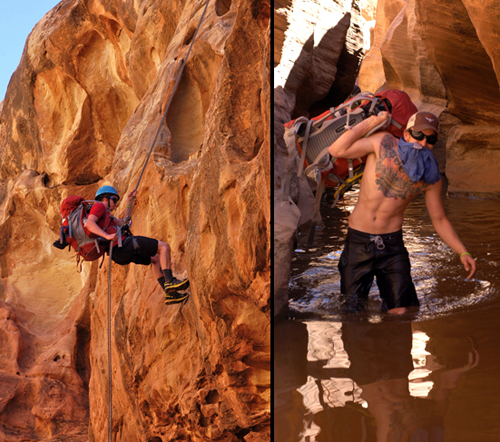
The initial tight entrance gave way to mile after mile of technical maneuvers as we got into the meat of the descent. Stemming, climbing, crawling, rappelling, scrambling up and down, spread-leg chimney moves — all were required to traverse down and through the inner reaches of the canyon. In between the technical canyon moves we followed scant trails, stretches of gravel, washes, slickrock, and sand.
Our route, a common descent through Gravel Canyon, is rated Canyon 3B III, meaning technical climbing skills are required. Fortunately, our visit in mid-April coincided with spectacular weather and little threat of rain, which can quickly add danger to a canyon descent, where flash floods can start, well, in a flash.
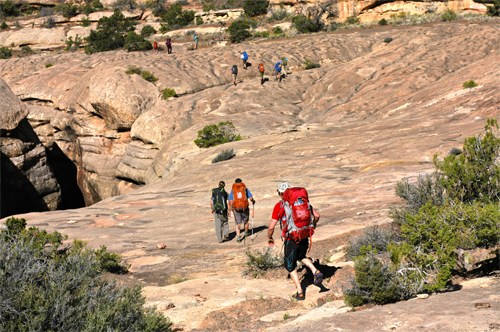
On my back, I carried a 60-liter pack, the Aether 60 from Osprey, loaded with camping and canyoneering gear plus some photo equipment. Our guide also had me haul food and four liters of red wine for the group — we were balancing adventure with a bit of luxury on this trip, no doubt!
Indeed, at the start my pack weighed a shoulder-burning 50 pounds. But as we hiked in, I cinched the pack tight and decided to try and forget about the load.

That was easy, it turned out, with the Aether pack. A slick suspension system and comfortable shoulder harness distributed the weight across my back, shoulders and hips. The few hot spots that developed during the first day of hiking were easily fixed by adjusting the load lifters that night.
Once dialed-in, the Aether pack kept my load snugly in place, wine and all. Even during rappels and technical stemming moves the pack did not noticeably shift.

In the depths of a canyon, good gear is essential to moving with comfort and speed. I ended the Utah trip still with dry hair — no embarrassing slips! My pack was lighter, trimmed of food and drink, as we hiked the remaining miles out. A good trip and a solid equipment test in canyons so deep sometimes you can’t see the sky.
—Sean McCoy is a contributor based in Denver. He last wrote about spring skiing on Mount Hood.



